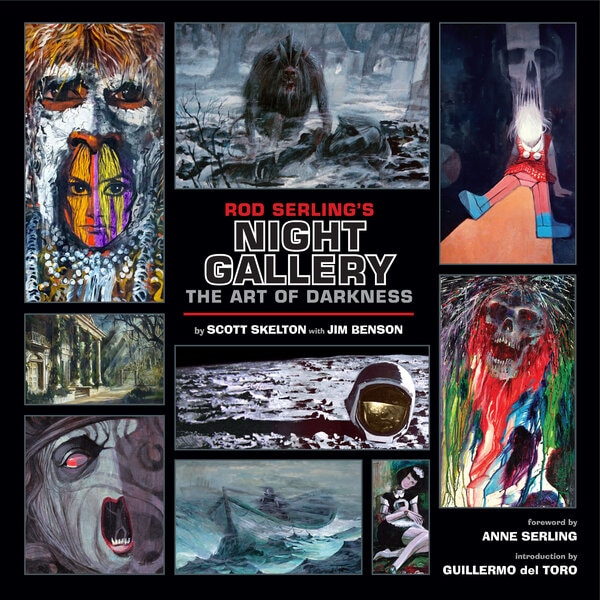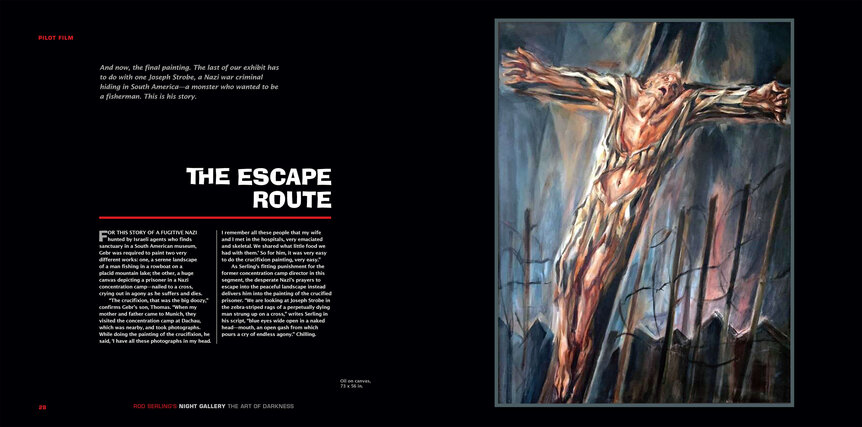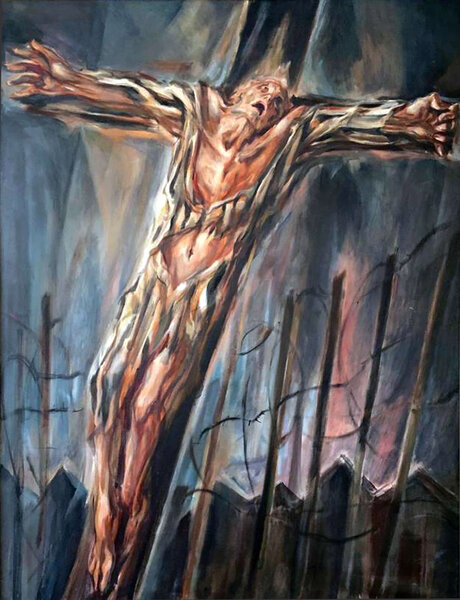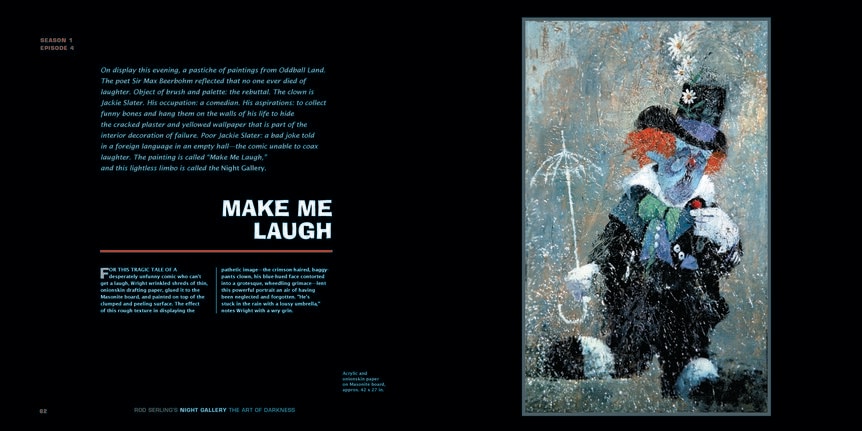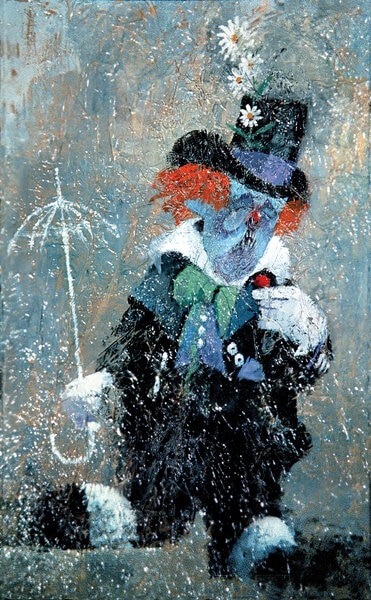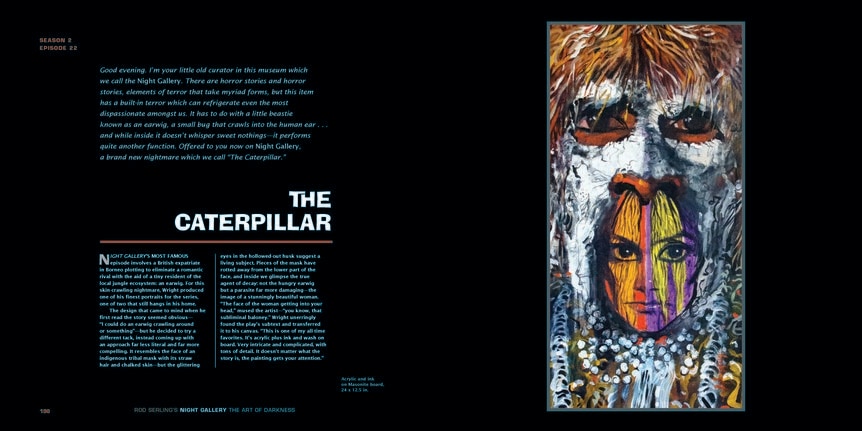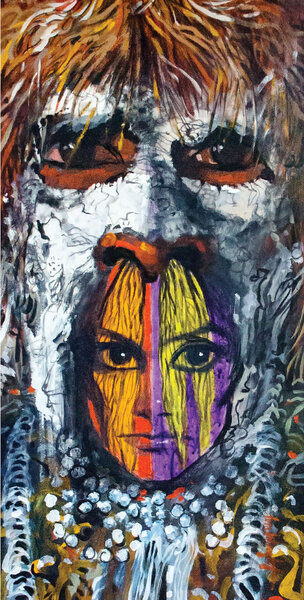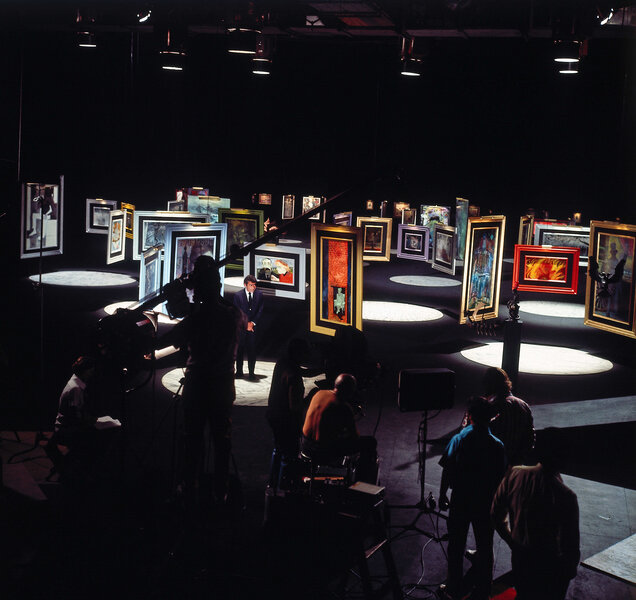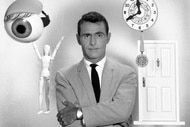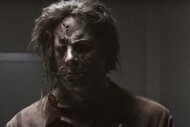Create a free profile to get unlimited access to exclusive videos, sweepstakes, and more!
'Night Gallery: The Art of Darkness' offers a private showing of Rod Serling's post-Twilight Zone series
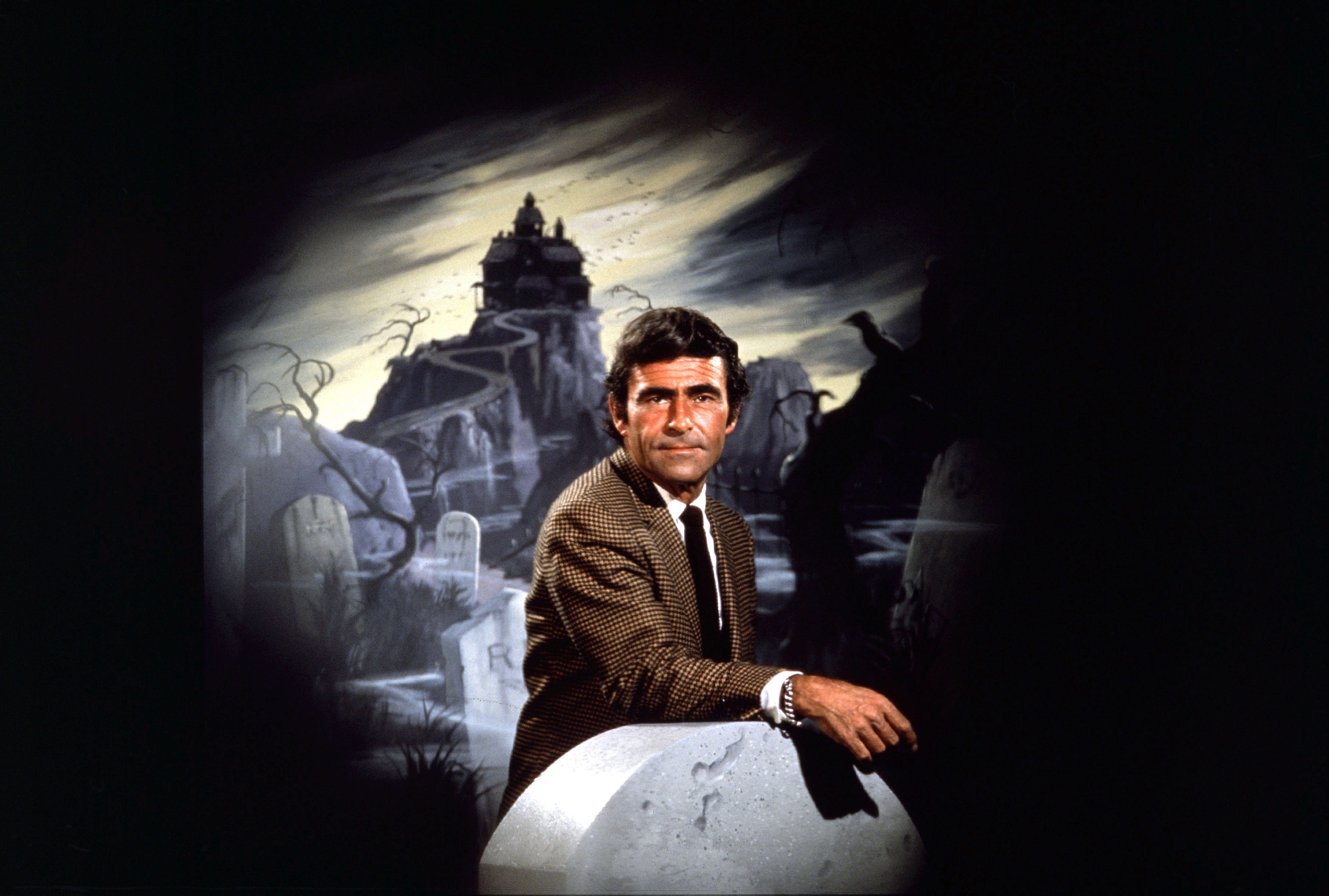
Hello there...we're your little ol' curators, and we'd like to welcome you to the Night Gallery.
If that title doesn't ring a bell, maybe the name Rod Serling will. The first thing that probably comes to mind is The Twilight Zone, but that hit series wasn't the Syracuse native's only foray into the world of televised anthologies with a genre twist. Between 1969 and 1973, NBC ran three seasons of Night Gallery, another show defined by a collection of disconnected stories set within the realms of fantasy, horror, and sci-fi. Also hosted by Serling — and his instantly recognizable voice — this program used an eerie and dimly-lit art gallery as its general framing device. Each episode was broken up into two to three segments, and each tale of the otherworldly was preceded by an original (and oftentimes creepy) painting.
All this time later, one book — Night Gallery: The Art of Darkness — will examine every single piece of artwork created for the show. Working tirelessly with Creature Features publisher Taylor White, authors Scott Skelton and Jim Benson tracked down as many of the original 101 paintings as they could, and when originals couldn't be located, Universal (owner of the IP) lent a helping hand.
"Part of the reason that this book is charmed and took so long is because technology had to catch up with what we were doing," White tells SYFY WIRE. "If we did this book five or 10 or 15 years ago, we would’ve been using these terrible, grainy frame grabs taken off of a computer monitor or a TV or whatever. It wouldn’t have been what it is. Universal was nice enough to let us go into their 35mm master prints and take gigantic scans of the frame grab, which were gorgeous."
In one instance, an incredibly rare portrait of Joan Crawford used in the pilot episode was discovered at the last minute in an Oregon storage unit. "We got a random email from a family," White reveals. "Their dad was a TV executive in Hollywood through the ‘60s and ‘70s and how he ended up with it, none of us really knows because it traveled from family homestead to family homestead for 50 years. We never had a clue and then in one email, everything changed … they had a photographer who took beautiful pictures and it’s in the book. It’s one of the holy grails."
Once the show was canceled, Universal placed the artwork into a props warehouse for several decades. Years later, the warehouse was being converted into the E.T. ride at Universal Studios and the company asked employees to buy off the old props in order to make room. Elsewhere, paintings changed hands via auction or they were simply taken by theft. The point is: these pieces were scattered all over the place, but Skelton offers a word of thanks to those individuals who decided to utilize the five-fingered discount.
"I have to thank these people, if they purloined paintings because they would not have survived Universal’s — I don’t want to call it neglect — they just didn’t know what they had," he says, adding that Hollywood memorabilia didn't really become a lucrative business until the 1990s. "What they were sitting on was gold mine in their prop warehouses. These people who managed to take them away to a secure spot probably did a lot of good."
Skelton and Benson were well-suited for this book, which has been in development for almost 30 years. Back in the late '90s, the duo wrote Rod Serling's Night Gallery: An After-Hours Tour, a viewer's guide to the show that is on par with Marc Scott Zicree's Twilight Zone Companion.
Creature Features was kind enough to provide SYFY WIRE with three exclusive interior pages from Night Gallery: The Art of Darkness (on sale in early December), including a foreword by Rod's daughter, Anne Serling (As I Knew Him: My Dad, Rod Serling: Serling), and an introduction by Oscar-winning director Guillermo del Toro (Shape of Water). Our first offering of the weird and horrific comes from Night Gallery's pilot, which aired 51 years ago this month.
Below, the haunting tableau (depicting a tortured soul dressed in the tattered rags of a striped concentration camp uniform and crucified on a cross) was created for "The Escape Route," the story of a Nazi war criminal hiding in South America. Hunted by Israeli Mossad agents, the unrepentant fugitive (played by Richard Kiley) tries to escape into the serene painting of a lone fisherman. He ends up having his wish granted, but not in the way he expected. After all, there had to be some kind of twist ending with Rod Serling at the helm.
The painting for this segment (now owned by del Toro) was one of the few pieces not created by artist/director Tom Wright. It was actually done up by Universal staff artist Jaroslav Gebr, a European immigrant who had firsthand experience with the horrors of Nazi cruelty during World War II. While Gebr and his family were not Jewish, they were persecuted for being intellectuals. His elder brother, a poet, was essentially worked to death in a munitions factory, and after the war, Jaroslav visited Dachau and hospitals where Holocaust survivors were recovering.
"He remembered those faces," says Skelton. "And when he painted that, when Rod gave him the opportunity to paint that, it was a huge effort for him and he put his body, soul, blood, and tears into it. It really is a horrifying examination of suffering … that was a huge influence and I believe that Jaroslav and his young son, Tom, agree that he always felt grateful to Rod Serling for giving him the opportunity ... It’s visceral. It packs quite a punch."
"I find that one to the be the absolute most unsettling and kind of disturbing in its own way and it works on so many different levels for all the ways Scott just explained," White adds. "But it is one that takes the painting to a level that hits you in a place that is unsettling."
The idea of a Nazi criminal facing supernatural punishment for their heinous crimes was familiar to Serling, who presented a similar story in Season 3 of The Twilight Zone with "Deaths-Head Revisited." As a person of Jewish heritage, Serling wasn't afraid to explore his own background in the scripts that he wrote. Judaism is a subject he'd later revisit in Season 2 of Night Gallery with "The Messiah on Mott Street," a profound rumination on Jewish culture, history, and faith that wouldn't feel out of place in a Coen Brothers project.
"He was extremely proud of his heritage. I know that he enlisted in the war, I think the day after he graduated, and he really wanted to go to Germany because he wanted to fight the Nazis. But, of course, he was sent to the Pacific," Anne Serling says. "As you said, about ‘Death’s-Head Revisited’ and this Night Gallery script, these are things that my dad was passionate about, felt needed to be told over and over again and remembered. They still need to be remembered and talked about."
On the subject of Gebr's painting, she describes it as "chilling."
The evening the pilot first aired, Anne was babysitting and decided to make a pseudo-prank call to ensure that her dad had another piece of quality television on his hands.
"I knew that my father was very apprehensive, when Night Gallery was about to air, that it would be seen or compared to The Twilight Zone," she recalls. "I was babysitting the night that it aired and when the kids went to bed, I called a random number and pretended I was somebody from the Nielsen Ratings and [asked] did they watch the show? Just something stupid that I did, but I was very protective of my dad and I wanted it to do well and whomever answered said, ‘Yes,’ she had, and I quickly hung up because I knew I shouldn’t be doing this."
Our next gallery offering comes from the Season 1 segment "Make Me Laugh," the story of a struggling comedian (Godfrey Cambridge), who gets more than he bargained for after a swami (Jackie Vernon) turns everything he says, no matter how trivial, into a hilarious punchline. This segment was one of two Night Gallery teleplays directed by a pre-Jaws Steven Spielberg (he also helmed the aforementioned story with Joan Crawford that first introduced the show to the world).
Wright, who would often be juggling three to five paintings at any given time during the show's fast-paced production, details the "unique technique" he utilized to encapsulate the episode's core themes in its introductory painting:
"Most of the paintings were done on masonite with acrylic because it withstood all the action: the beats, the walk overs. But the clown was done by wrinkling up the yellow tracing paper that draftsman use to do their drawings on. I wrinkled it up, glued it all to the board, and the painting was all done on this real wrinkly paper just because it needed a different look and, of course, the clown was a different look. It had an interesting history and a lot of people really liked the painting. It had a whole interesting way to get to."
"I would have [the paintings] lined up in my studio and once I got the idea, I would just start working on them," continues Wright, who used his daughters and then-wife as character models. "We had schedules, so I was going by the schedules, of course. I’d just keep hitting them and then this one would get closer, they had to have [it], so I would bring up the prop guys, they would make the frames up for me, paint the frames for me, get it all ready to go. I’d call [and say] ‘Painting’s ready’ and boom! They’d come up, pick it up, put it all together, and next time I saw them, we were on the stage doing the set-up in the gallery."
When the network saw the footage that Spielberg had shot for "Make Me Laugh," they absolutely hated it. "In fact, there was one NBC executive who said, ‘I don’t want to see this guy get another show ever again,’ which could have ended his career right there. Luckily, [executive producer] Jack Laird told him to stuff it," Skelton says. Nevertheless, Jeannot Szwarc (another up-and-coming director who helmed about two dozen Night Gallery segments) was brought in to do some reshoots.
"What you’re seeing is essentially an amalgam of what Spielberg shot and what somebody else tried to fix, but even Jeannot said, ‘I couldn’t see what he’d done wrong. I essentially shot everything like he did it,’" Skelton continues. "It was never to NBC’s liking; it falls short because frankly, Rod’s writing is pristine and if it had been cast a little differently, it would have been a stronger piece. But visually, I have no complaints. The thing is sensitive to what Rod is writing, it’s rich in good visuals, and it’s great television up to a point."
Our final item this evening is called "The Caterpillar," a painting created for what may be the most infamous Night Gallery segment ever produced. Written by Serling and directed by Szwarc, this uncomfortable yarn deals with a scheming British ex-pat (Laurence Harvey) in the jungles of Borneo, who has a rather unpleasant encounter with a type of insect that crawls into the human brain.
The artwork for "The Caterpillar" is among Wright's favorites and currently hangs in his home. Instead of focusing on the titular beastie, he decided to capture the jungle setting, as well as the ex-pat's lust for a young woman (Joanna Pettet), whom he intends to woo after murdering her husband (Tom Helmore) with a strategically-placed earwig. Naturally, things don't go as planned and the tables are turned on the main character in a gruesomely karmic fashion.
"I found it one of the more interesting scripts and I liked the whole venue, the whole genre, everything was working nicely for me in it," the artist recalls. "You’ll notice the native in the painting and then the girl’s face — she was the main character, really besides the gentleman in this show. I finally came up with the idea of putting them together in a weird way and it came out, I thought, very nicely and it became one of my favorite paintings through the other hundred or whatever I did ... It’s the mood of the painting and the composition. People have looked at it and went, ‘God, that really scares me.’ That’s the first thing a lot of fans tell me: ‘My favorite painting is this and it scared me to death’ because they were six-years-old when they saw it and they said they couldn’t go to sleep. This was the paintings, not even the show!"
"It’s got a kind of pop art and primitive feel to it at the same time. I thought he perfectly captured the concept behind the story. It looks like some sort of primal mask or something," adds Skelton. "The painting is one of his conceptual best, I always thought. Simple because of [it being] the bug eating away [at something], which would’ve been an obvious choice. He didn’t choose that; he chose the face of the woman eating away at him. I thought that was a brilliant concept and he really captured that episode really well."
"A big thing doing the paintings — you had so many to do, that what can [you] do that’s gonna be different, because we wanted each one of them to look like a different artist had done them. The technique changed on every painting a little bit, the style, colors, everything. It was really a challenge," reveals Wright, who started his career as a concept artist for Hitchcock and Coppola films before jumping into the director's chair for a host of TV shows like Castle and Supernatural.
Getting back to the subject at hand, the shocking twist in "The Caterpillar" is among the best Serling ever put onscreen. Based on the short story "Boomerang" by Oscar Cook, it's definitely worthy of standing alongside the most iconic episodes of The Twilight Zone.
"From the entire series, if you ask anybody, it is the one ending that virtually everybody remembers from 50 years ago," White says. "It’s been talked about, I think Stephen King’s written it up, Guillermo del Toro talks about it. It’s really just this unthinkable twist that has literally burrowed its way into our psyches and has never left. Even five decades ago, it’s the most despicable, grotesque thing to think about."
In December 2018, it was announced that a revival of the series was in development from Jeff Davis (Teen Wolf) and David Janollari (Midnight, Texas). There haven't been any updates since that time, which leads White to believe that the project is no longer moving forward.
"I think at the moment, it’s dead in the water, but it is an idea that I think its time has come again," he says. "Anthologies are bubbling up in droves with Creepshow and [the new Twilight Zone]. They're on every channel now, so it kind of makes sense that a Night Gallery reboot would find its way back. We’ll see. I mean talk about a dream come true to have Tom do new paintings for a reimagined Night Gallery. It’d be astonishing."
"I can tell you unequivocally that my dad would be stunned that we’re even all on this conversation," Anne continues. "[He] would be so surprised because he was once quoted in an interview that he didn’t think he’d be remembered. That his writing would not stand the test of time. Obviously, [he was remembered] and that’s because he dealt with human issues that we’re still sadly dealing with now: racism, etc."
She concludes: "It’s amazing to me and I hear from people who write me and tell me what an influence my dad had on them professionally. They became writers, they say, because of my dad or that when they were kids, they would watch the show and many had tumultuous childhoods and would think of my dad as their father. It’s so touching and moving and surprising to hear these stories after all this time. Obviously, I feel this tremendous personal loss, but to hear other people expressing their loss, it’s just — what can I say? — it’s amazing."
Night Gallery: The Art of Darkness starts shipping out Tuesday, Dec. 1. You can pre-order a copy right here and choose from two different editions: the hardcover ($95) and the softcover ($75).
